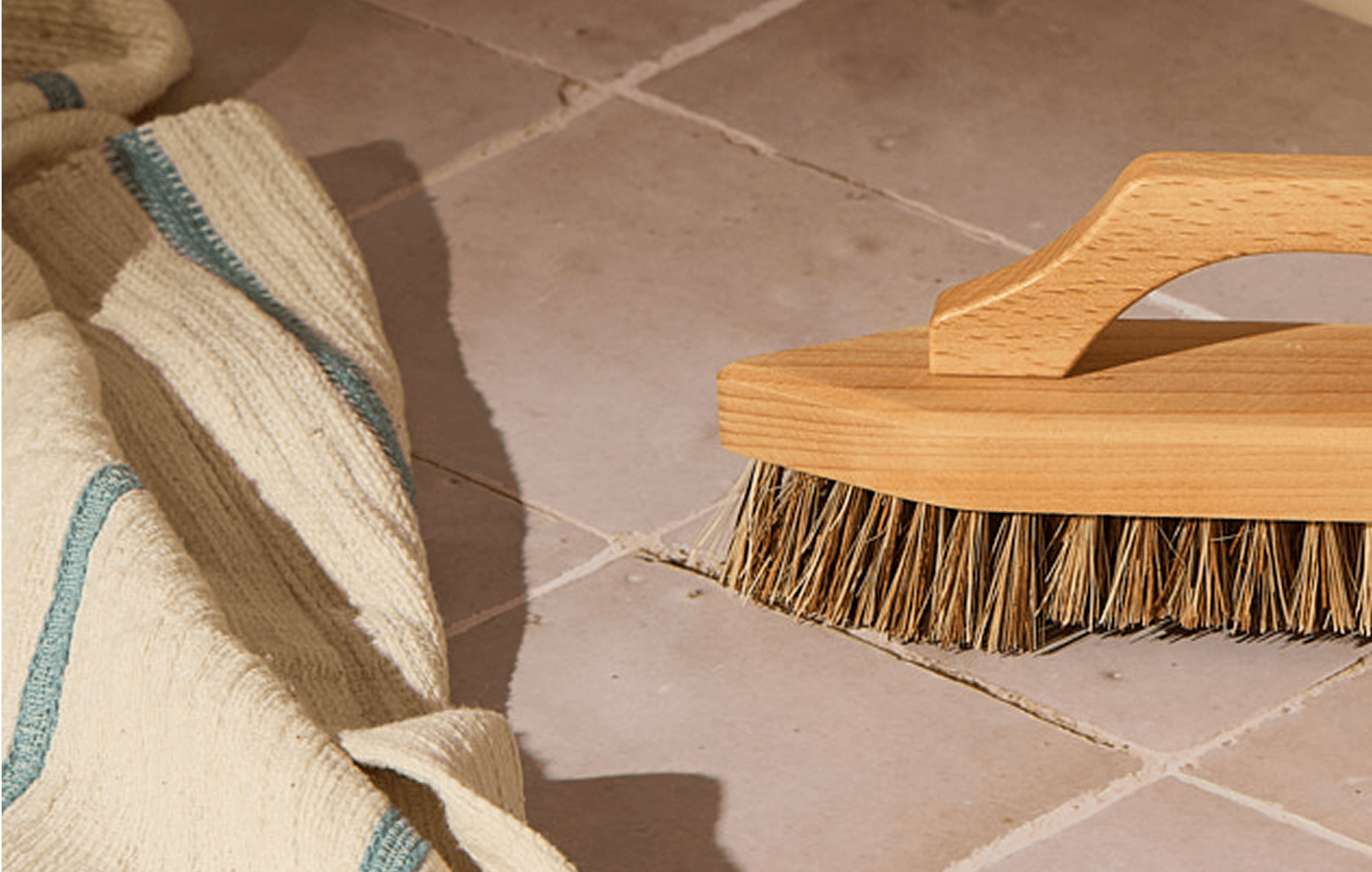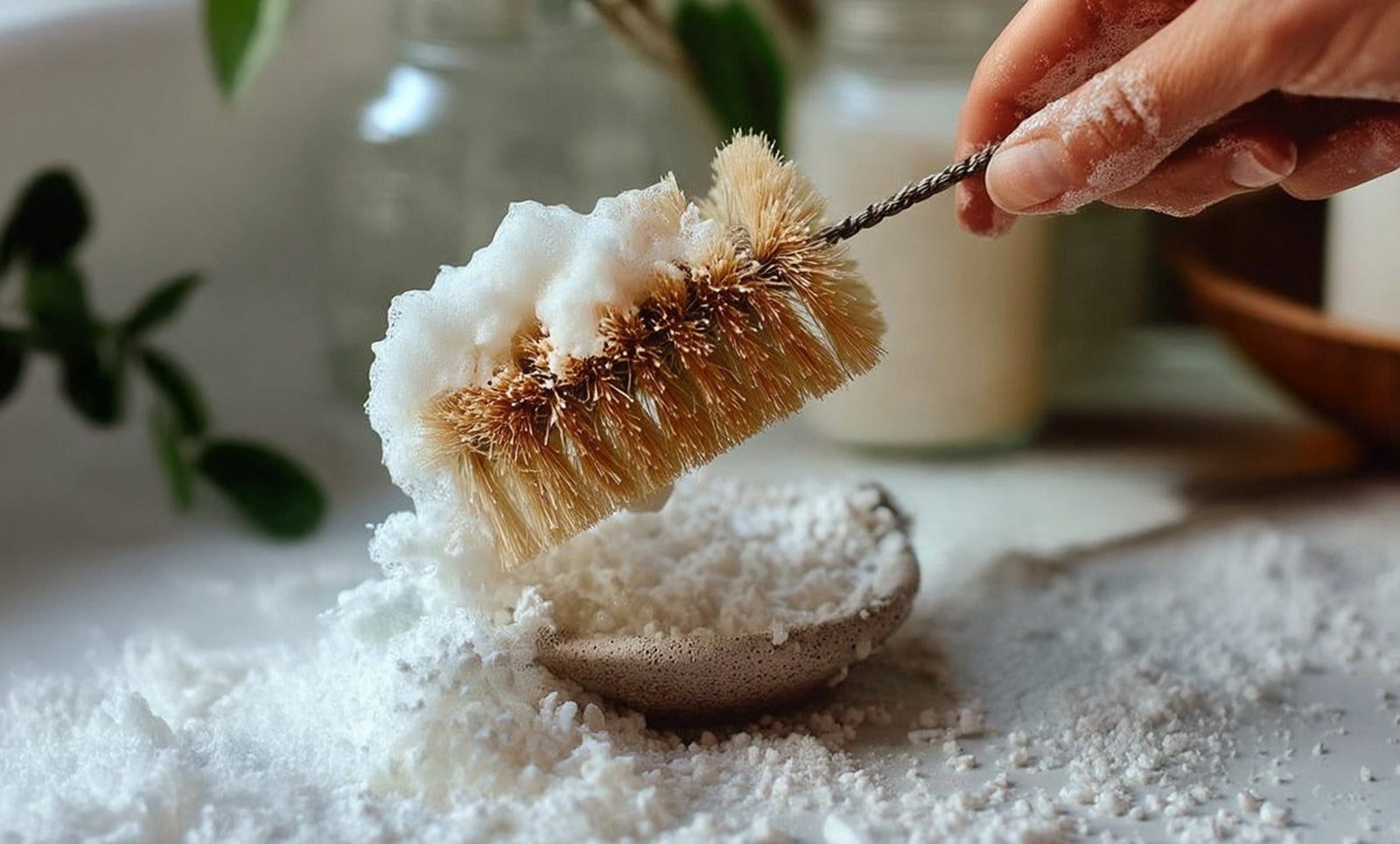How to Clean Bathroom Grout with Hydrogen Peroxide

If you’re looking for a safer, less toxic, yet effective way to clean, whiten and brighten bathroom grout, hydrogen peroxide will be your new best friend.
Who knew that an inexpensive brown bottle of peroxide could do so much?
Here, you’ll learn how to clean bathroom grout with Branch Bathroom Spray to remove soap scum, dirt, grease, mold, and mildew. Then, follow up with hydrogen peroxide and Branch Basics Oxygen Boost to whiten and brighten your grout and eliminate any missed mold.
You will also learn tips for keeping your grout clean between cleanings.
The Importance Of Grout Cleaning
Tile grout can look fabulous or gross, depending on how it’s cleaned and maintained.
Since grout is porous (and cumbersome to scrub thoroughly), it’s susceptible to collecting and holding onto soap scum, mold, mildew, bacteria, dirt, and grime.
It’s especially important to keep bathroom tile clean, as the combination of humidity, soap scum, dirt, skin cells, and other bathroom grime makes grout a perfect breeding ground for mold, mildew, and build-up.
Regular grout cleaning will also extend the life of the grout and tiles.
The key to making this chore less cumbersome is keeping up with it, and peroxide plus Branch Basics Oxygen Boost or Baking Soda are your ultimate grout-cleaning allies.
Related reading: How To Remove Mold From Shower Grout Naturally.
How To Clean Bathroom Grout With Hydrogen Peroxide And Branch Basics Oxygen Boost
3% hydrogen peroxide is excellent for household cleaning and disinfecting, whitening and brightening surfaces, and killing mold and mildew.
However, combining 3% peroxide with the unbeatable grime-busting, gentle scouring, mold-killing power of Branch Basics Oxygen Boost (baking soda + powdered peroxide/sodium percarbonate) makes grout cleaning a cinch.
Here’s how to clean bathroom grout using hydrogen peroxide and Oxygen Boost:
What you’ll need:
- Branch Basics Bathroom Cleaner
- 3% hydrogen peroxide (brown bottle), preferably with a trigger sprayer attached
- Note: You can pour hydrogen peroxide into a spray bottle, but we recommend storing it in its original brown bottle to extend shelf life
- Note: You can pour hydrogen peroxide into a spray bottle, but we recommend storing it in its original brown bottle to extend shelf life
-
Branch Basics Oxygen Boost
- A scrub brush, toothbrush, or tile brush
- Microfiber cloth
How to clean:
- Always clean the grout and tile first with Branch Basics Bathroom cleaner and a microfiber cloth. This removes germs, dirt, grime, and mold from the surface. Our goal is to remove the mold as prescribed in mold remediation. Then, if somehow some mold is left behind, the hydrogen peroxide and Oxygen Boost will complete the cleanup!
- Spray grout lines liberally with 3% hydrogen peroxide.
- Sprinkle with Oxygen Boost (acts as an abrasive for more removal power). Wet the Oxygen Boost with a spray of Branch Basics Bathroom solution or more 3% hydrogen peroxide.
- Let sit for 1-5 minutes (the longer, the better).
- Scrub with a toothbrush, grout brush, or scrub brush.
- Rinse or wipe off with a microfiber cloth to remove dirt, mold, mildew, and grime.
- Finish by spraying straight hydrogen peroxide on the grout lines (you can add a spray bottle cap directly to your hydrogen peroxide bottle to make this easy) to kill any remaining mold and keep it from coming back.
- Let dry.
While you’re at it, you can also use Branch Basics Bathroom alone or with Oxygen Boost to scrub your tub or shower basin, clean the toilet, and clean your sink.
We recommend repeating this weekly to keep your grout mold-free, clean, and free of dirty build-up.
Related reading: How To Clean Your Bathroom Naturally With Branch Basics
How To Clean Bathroom Grout With Hydrogen Peroxide And Baking Soda
Although peroxide plus Branch Basics Oxygen Boost is our preferred method, you can use 3% hydrogen peroxide with plain old baking soda (a mild abrasive) to clean bathroom grout.
Here’s how to clean bathroom grout using hydrogen peroxide and baking soda.
What you’ll need:
- Branch Basics Bathroom Cleaner
- 3% hydrogen peroxide (brown bottle), preferably with a trigger sprayer attached
- Note: You can pour hydrogen peroxide into a spray bottle, but we recommend storing it in its original brown bottle to extend shelf life
- Note: You can pour hydrogen peroxide into a spray bottle, but we recommend storing it in its original brown bottle to extend shelf life
- Pure baking soda
- A scrub brush, toothbrush, or tile brush
- Microfiber cloth
How to clean:
- Always clean the grout and tile first with Branch Basics Bathroom cleaner and a microfiber cloth. This removes germs, dirt, grime, and mold from the surface. Again, our goal is to remove the mold as prescribed in mold remediation. Then, if some mold is left behind, the hydrogen peroxide and baking soda will complete the cleanup!
- Spray grout lines liberally with 3% hydrogen peroxide.
- Sprinkle with baking soda. Wet the baking soda with a spray of Branch Basics Bathroom solution or more 3% hydrogen peroxide.
- Let sit for 5-10 minutes (the longer, the better).
- Scrub with a toothbrush, grout brush, or scrub brush.
- Rinse or wipe off with a microfiber cloth to remove dirt, mold, mildew, and grime.
- Finish by spraying straight hydrogen peroxide on the grout lines (you can add a spray bottle cap directly to your hydrogen peroxide bottle to make this easy) to kill any remaining mold and keep it from coming back.
- Let dry.
We recommend repeating this weekly to keep your grout mold-free, clean, and free of dirty build-up.
Related reading: Cleaning With Baking Soda (Sodium Percarbonate): 12 Surprising Uses
Advantages Of Using Peroxide Vs. Bleach For Cleaning Grout
Bleach-based cleaners have been the go-to option for cleaning bathroom grout for decades. They’re also an old stand-by for mold removal.
However, did you know the EPA no longer recommends bleach for mold and mildew removal?][1]
They now recommend hydrogen peroxide because it is much more effective at killing mold on and below surfaces and much safer for human use.
This is why remediation professionals now use a combination of HEPA vacuuming, cleaning with soap and water to remove the mold, and following up with peroxide.
So, you can feel really good about tossing your old bleach-based cleaners and mold removers.
Still on the fence?
Check out our article outlining the harms of bleach for fertility, immunity, gut health, respiratory health, children’s health, pregnancy, and more in: Is Sodium Hypochlorite (Bleach) Toxic?
Toss The Toxins With Branch Basics
Branch Basics Made Safe Certified, plant- and mineral-based, and cruelty-free cleaning line pairs perfectly with the power of hydrogen peroxide for safer, more natural cleaning.
Branch Basics All-In-One Concentrate plus Oxygen Boost provides everything you need to replace every single toxic cleaning and laundry product in your home with a human-safe and pet-safe alternative.
Our refillable Premium Starter Kits (available in glass or plastic) contain all you need to make:
- 3 Bottles of All-Purpose @ $3.09 ea
- 3 Bottles of Bathroom @ $6.18 ea
- 3 Bottles of Foaming Wash @ $3.09
- 1 Bottle of Laundry @ $0.26 per load
- 3 Bottles Streak-Free @ $0.49 ea
Using just Branch Basics Concentrate plus water. Talk about safe, simple, and economical!
Learn more about how our all-in-one cleaning system works here.
Frequently Asked Questions
Now that you’re an expert on cleaning bathroom grout with peroxide, let’s answer some FAQs.
How Often Should I Clean Grout?
We recommend cleaning grout weekly using either method outlined here.
If you’re single, you could probably get away with cleaning every other week, but the more you clean, the less build-up you’ll have to deal with later.
Will Hydrogen Peroxide Damage Grout?
No. Unlike harsh bleach, hydrogen peroxide is 3% peroxide in 97% water, making it a safe and gentle solution for porous materials like tile grout.
Will Vinegar Work Instead?
Straight vinegar plus baking soda may work fine for everyday grout cleaning.
However, it won’t whiten and brighten your grout or address mold or mildew issues, which is why we recommend peroxide instead.
Also, never mix vinegar and peroxide (or store them together), as this will create toxic fumes that can be very harmful to people and pets.
Is Hydrogen Peroxide Natural?
Some chemicals occur naturally, and some are manufactured.
Hydrogen peroxide is made up of two hydrogen and two oxygen (H2O2) molecules. Our bodies, animals, plants, and even some bacteria produce hydrogen peroxide as a byproduct of metabolic processes. It is a natural substance produced by animals and plants.
It is also a byproduct in nature when water vapor reacts with ozone and sunlight.
Hydrogen peroxide can also be manufactured in a laboratory for a wide range of products used for cleaning, medical applications, food processing, cosmetics, and more.
For this reason, hydrogen peroxide is approved for oral use in toothpaste for teeth whitening systems and topically as a disinfectant.
Peroxide is also 100% biodegradable and won’t harm the planet.
What Other Ways Can I Use Peroxide For Cleaning?
Peroxide is truly a product of a thousand uses, especially for low-tox, eco-friendly cleaning, laundry, and disinfecting.
See How To Use Hydrogen Peroxide As A Safer Alternative for Cleaning, Disinfecting, And More for more advice on how to use it safely around the home.
References Mentioned In This Article:

Marilee Nelson
Marilee Nelson is an Environmental Toxins expert who has spent nearly 30 years advocating for the chemically-sensitive and chronically-ill. She is a Board Certified Nutritionist, Certified Bau-Biologist and Bau-Biology Inspector and specializes in Food As Medicine. She has helped thousands of families and individuals identify, heal and recover from toxic exposures and is on a mission to revolutionize the way American families view their health.








